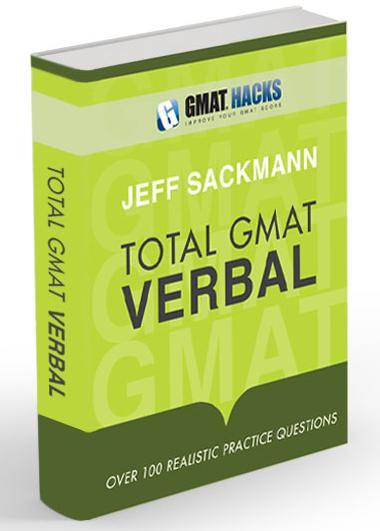
Bookshelf
|
|
Total GMAT Math Jeff's complete Quant guide, on sale now! |
|
|
Total GMAT Verbal Everything you need to ace GMAT Verbal! |
1,800 Practice Math Questions
Buy Jeff's books at Amazon.com

GMAT Official Guide, with IR
OG Math | OG Verbal
OG12 & Quant Rev solutions!
GMAT Question of the Day
Beginner's Guide to the GMAT
GMAT Hacks Affiliate Program

Recent Hacks

Categories
- General Study Tips
- Goals and Planning
- CAT Strategy
- The Mental Game
- GMAT Math Strategy
- GMAT Math Topics
- Mental Math
- Data Sufficiency
- Critical Reasoning
- Reading Comprehension
- Sentence Correction
- Analytical Writing Assessment
- Integrated Reasoning
- IR Explained
- Business School Admissions
- GMAT Prep Resources
- Practice Questions
- Total GMAT Math
- Total GMAT Verbal
- GMAT 111

All About the GMAT AWA
| You should follow me on Twitter. While you're at it, take a moment to subscribe to GMAT Hacks via RSS or Email. |
The Analytical Writing Assessment (AWA) is the neglected stepchild of the GMAT. No one (test-takers or business schools) considers it as important as the rest of the test, and it's scored separately from the Quantitative and Verbal parts of the exam. Heck, it's even relegated to the very back of The GMAT Official Guide.
It's true: there's no reason to spend nearly as much time preparing for the AWA as you do for the rest of the test. It's a mistake to forget about it entirely, though:
- A small amount of effort can translate into a big difference in score.
- The schools you apply to can see your actual essays.
What is the AWA?
The AWA consists of two 30-minute essay questions, the Analysis of Issue and the Analysis of Argument. The first gives you a general topic, and you are asked to write an essay arguing for one side or the other. The second gives you a prompt not unlike the passage in a Critical Reasoning question and asks you to–big surprise!–analyze the argument.
How is the AWA scored?
Your essays are scored on a scale from 0 to 6 in half-point increments. Each essay is initially graded by a human and a computer. If they disagree by more than a point, another human comes along, separates the brawling human and computer graders, and settles the dispute. The GMAC reports that the human and the computer differ in a relatively small number of cases, so it's not something to lie awake worrying about.
How Does the Computer Grader Work?
Good question. I'd love to see the source code of that thing, but in the meantime I'll have to stick with educated guesses. It can measure the quality of your vocabulary (as well as relevance to the topic), as well as proper use of transition key words, such as "however." I can't imagine it recognizes the great ideas you put in your essay, but it does seem to pick up on the rest.
Why Do B-Schools Get to See My Essay?
Part of the reason the AWA is included on the GMAT is because some applicants might try to cheat. Plagiarized or ghost-written essays are a problem at every level of admissions, so if the person evaluating your application essays can also see how you wrote during the GMAT, they might notice if there's a big difference.
They don't expect your GMAT essays to be perfect–they know you only have half an hour for each one–but they also don't expect you to read like John Updike in your application essays and like a chimpanzee on your AWA.
How Can I Prepare?
Write a practice essay or two, for starters. In the back of The GMAT Official Guide, there is a list of all possible essay prompts. (Yes, the actual prompts used on the test.) It would be a waste of time to write, or even outline, essays for each of them, but it is worth your time to scan through them, making sure you understand each one.
Focus on quality over quantity: a perfect 250-word essay is better (both for the AWA grader and for admissions officers) than a rough 400-word version. Allow yourself plenty of time (at least five minutes) at the end of the half-hour in order to carefully proofread your essay for grammar and punctuation. The little things aren't going to affect your score much, but if you know how to use a comma, you might as well let the AWA grader know that.
Most all, don't try to accomplish too much. The object of the AWA is to determine whether you can write a coherent sentence and an organized paragraph or two. Organize your thoughts before you start to write, and keep things simple. Don't stress yourself out: you've got two and a half hours of testing left after you finish your second essay!
About the author: Jeff Sackmann has written many GMAT preparation books, including the popular Total GMAT Math, Total GMAT Verbal, and GMAT 111. He has also created explanations for problems in The Official Guide, as well as 1,800 practice GMAT math questions.
 |
Total GMAT Verbal
The comprehensive guide to the GMAT Verbal section. Recognize, dissect, and master every question type
you'll face on the test. Everything you need, all in one place, including 100+ realistic practice questions. |